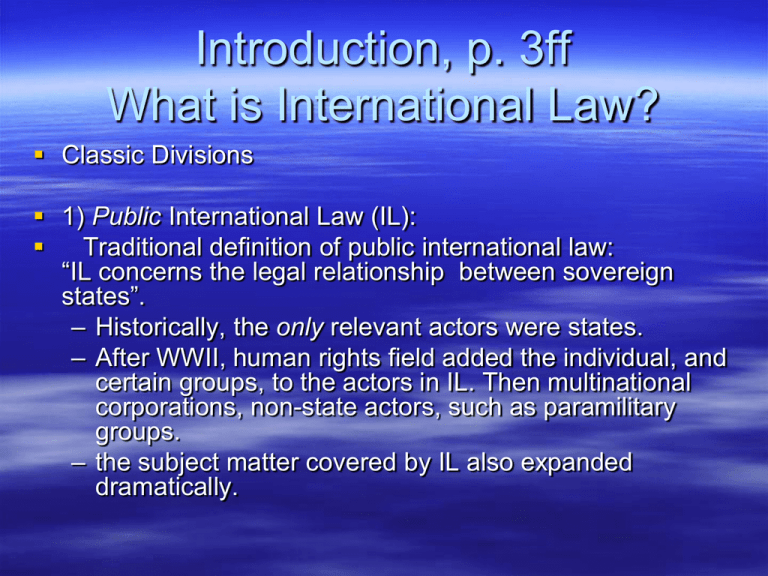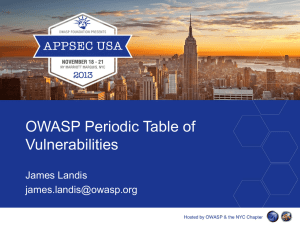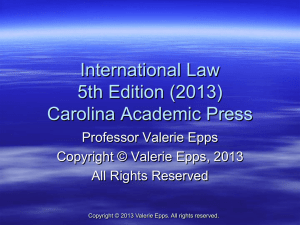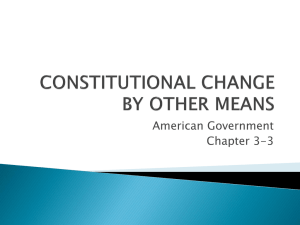Ch1Powerpoint - Pleasant Valley Music
advertisement

Introduction, p. 3ff What is International Law? Classic Divisions 1) Public International Law (IL): Traditional definition of public international law: “IL concerns the legal relationship between sovereign states”. – Historically, the only relevant actors were states. – After WWII, human rights field added the individual, and certain groups, to the actors in IL. Then multinational corporations, non-state actors, such as paramilitary groups. – the subject matter covered by IL also expanded dramatically. Classic Divisions continued 2) Private International Law: legal relationships occurring in international business transactions and the legal regime that governs them: e.g., WTO (World trade Organization), TRIPS (Trade Related Intellectual Property), intellectual property treaty rights, international trade, transnational commercial contracts, transnational taxation etc. this course focuses on public IL, although much of what you learn here will be applicable and useful in private international law courses, e.g., the law of treaties, international jurisdiction, how international courts work, etc. So…What is International Law? First, what is law? If you landed in a new country and wanted to know if it had a legal system, what sort of structures would you look for to answer that question? How Is IL Made and Who Makes It? Is there an international legislature? Is there an international executive? Is there an international judiciary? If not, or if only in a rudimentary sense, how does IL get made? Can it really be said to be a system of law or is it just a set of hopeful prescriptions? What are the sources of IL. See ICJ Statute. Sources of IL, p. 5ff Custom 1) Custom What is custom? “A consistent practice of states engaged in by them out of a sense of legal obligation.” How consistent does the practice have to be? What sort of practices? What is a sense of legal obligation? Does custom bind even those states that disagree with the custom? What is opinio juris? What is a jus cogens custom? Article 38 Statute of the ICJ Statute of the International Court of Justice (ICJ) (www.icj-cij.org) sources of law that may be applied by the ICJ (Art. 38): – – – – – International conventions, international custom, general principles of law, judicial decisions (but see art. 59 of ICJ’s Statute, Doc. Supp. p. 35) teachings of international law scholars as a subsidiary means for determining the rules of law. The Paquete Habana, U.S. Supreme Court 1900 What was the custom found by the S.Ct. in The Paquete Habana? (US court decision, but typical of the way national courts go about finding international custom). How did the court go about finding the custom? What persuaded the court that the custom was binding? Why are US courts obliged to follow international custom? Would the court have followed the custom if Congress had passed a law stating that no vessels were exempt from capture as prize of war? If there is an internationally binding custom, are states free to pass contrary legislation? If they are, won’t that mean that states are only bound by custom if they want to be so bound? The Relationship of IL to Domestic (National) Law Common law and civil law countries usually incorporate IL into domestic law provided it does not conflict with existing national law. A few states make IL supersede national law. All states enter into agreements with other states (treaties). Some nations require legislation before the treaty will become operative as law but others make treaties operative as soon as the required national and international procedures are completed. The Relationship of IL to Domestic Law (continued) Can subsequent legislation override existing treaties? The answer in the US, and a number of other countries, is “Yes” but other countries make treaties supreme over regular legislation. Note: At the international level, a state may not rely upon its internal legislation to excuse nonperformance of an international obligation. (Vienna Convention on the Law of Treaties, arts. 27 & 46, Doc. Supp. p.110 & 115). Abdullahi v. Pfizer, Inc U.S. Ct of Appeals 2009 What was the binding international law custom found in the Abdullahi Case? What sources of law did the majority opinion rely upon? Is the US a party to the ICCPR? www.un.org If so, why didn’t the plaintiff’s lawyers rely on that treaty to clinch the case? Why did the dissenting judge disagree with the majority? If Nigerian governmental officials had agreed to go ahead with the treatments without patient or parental consent, thus probably barring actions in Nigerian courts, should Nigerians be able to sue in US courts? Regional Custom In the Asylum Case (Colombia v. Peru) 1950 I.C.J. 266, the ICJ accepted the idea of regional custom, that is a custom not found among nations generally, but found in a particular region of the world. Colombia had invoked Latin American regional custom. The ICJ, however, found that Colombia had failed to prove the regional custom because there was a lack of uniform practice accepted as law. Special or Local Custom In the Right of Passage Case (Portugal v. India) 1960 I.C.J. 6, the ICJ agreed that custom could arise between two (or a limited number of) states where there had been a long practice accepted as law. Portugal argued that two local customs had arisen and were binding on India. The ICJ agreed with Portugal with respect to one of the local customs but not with respect to the other. Jus Cogens States are usually free to disregard international custom by passing contrary laws, with the result that they will not be bound by the custom. There are some customs, however, which states are not free to reject. These customs are considered to be fundamental law or “jus cogens”. How do customs become jus cogens? There is disagreement on which rules fit this category but, for example, many agree that the following prohibitions would meet the requirements: torture, racial discrimination, genocide, war crimes, crimes against humanity, slavery and piracy. Which other rules should be in this category? Treaties as a Source of IL Treaties, of course, bind the parties. Can treaties bind non-parties? By what method? How can treaties provide a general source of IL? North Sea Continental Shelf Cases (FRG v. Denmark and Netherlands) 1969 I.C.J. 3 www.worldatlas.com/aatlas/infopage/northsea.gif What does art. 6(2) of the 1958 Geneva Convention on the Continental Shelf state? Why did Denmark and the Netherlands think that art. 6(2) applied to FRG even though FRG was not a party to the treaty? What is a reservation to a treaty? Why did the Court not accept the argument that the equidistant principle had become a rule of customary law? How much state practice would satisfy the Court that a practice had become customary law? What sort of evidence would you present to the Court to demonstrate opinio juris? General Principles of Law as a Source of IL What are general principles of law? Examples? Which general principles of law were applied in the Chorzow Factory Case? Judicial Decisions as a Subsidiary Source of IL Why do judicial decisions only serve as a subsidiary source of IL law? Exactly how are judicial decisions used by International Courts as a source of IL law? What does article 59 of the ICJ Statute say? What does it mean? Writings by Scholars of IL as a Source of IL Why does there seem to be reluctance by international judges to refer to scholars’ work to support their conclusions of law? Other sources might be found in UN General Assembly Resolutions provided they express custom.










